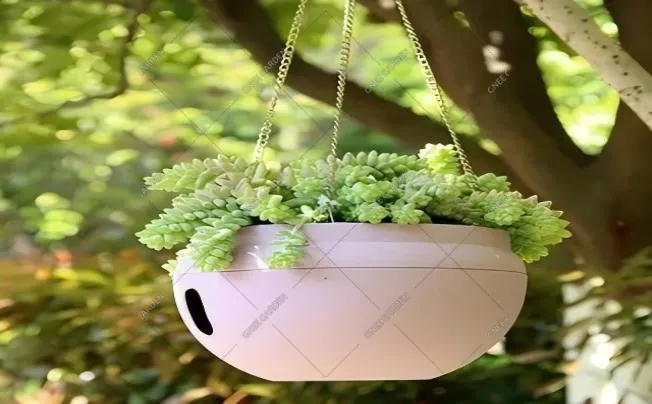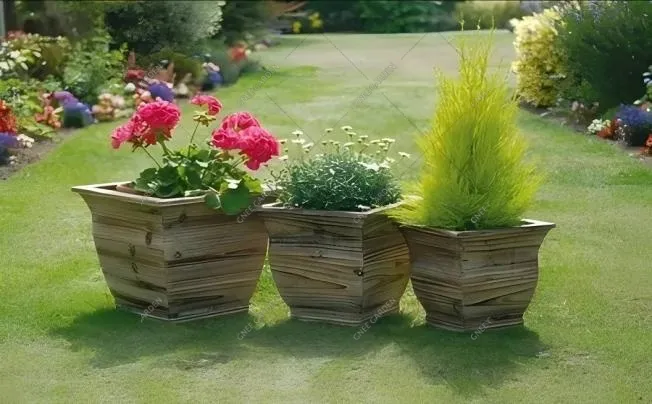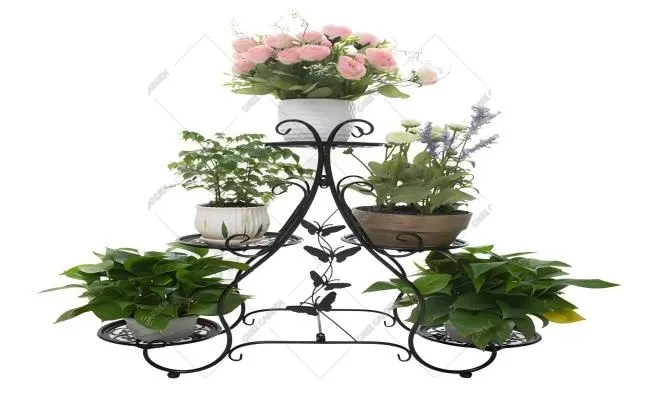What Are Some Tips For Choosing Garden Flower Pots?
The material, size, and shape of the pots, the traits of the plants, your personal aesthetic preferences, and your budget can all be taken into account when selecting garden pots.
Comparison of flower pots of various materials
1. Lightweight and useful plastic pots
Flower pots made of plastic are "regulars" in the market and are reasonably priced, typically costing only a few to over ten yuan. They are lightweight, portable, and simple to lift with one hand, much like the typical gallon and Alice pots. They are easy to move, even for a less strong gardening newbie. Additionally, plastic pots come in a variety of plain colours and designs to suit a range of aesthetic preferences. Its low air permeability, however, makes it easy for water to accumulate and cause soil compaction. To improve drainage and air permeability, it is advised to use a plastic pot with a thicker composition and a porous bottom. You can also lay a layer of ceramsite on the bottom of the pot to help water repellency.
2. Ceramic flower pots
These magnificent ceramic flower pots, which are baked at a high temperature and have a solid texture and attractive painted patterns, are like works of art that enhance the beauty of flowers. Large ceramic pots, on the other hand, are heavy, difficult to move without two persons, have poor air permeability, drain slowly, and are vulnerable to root rot and water buildup. You can choose a ceramic pot with a shallow body and a porous bottom for indoor care, set it up in an area with good ventilation, and water it using the adage "water thoroughly when the soil is dry."
3. Breathing "little experts" are clay pots
Pots made of clay have exceptional air permeability. Because of their rich surface pores and natural clay firing, they function similarly to a "breathing channel" for plant roots, enabling them to freely "breathe" and absorb nutrients. However, clay pots are costly, brittle, and readily broken in collisions. To keep them from breaking, handle them carefully when using them and stay away from extremes of heat or cold.
4. Additional resources
Modern, strong, and long-lasting, metal flower pots (such those made of iron art and stainless steel) are ideal for designing patios with an industrial or minimalist aesthetic. Insulation is necessary because metal conducts heat quickly and summer temperatures can easily burn plant roots. Because glass flower pots are so transparent, you can see the roots growing when plants are grown hydroponically. Although they are delicate and only suitable for hydroponics, they are lovely and fascinating. You can make your own wooden flower containers, which are naturally warm and ventilated. Small green plants can be planted with them. To avoid mildew, make sure they are moisture-proof and anti-corrosive, and replace them frequently.

Tips for choosing flower pots
Precise size selection
1. The size of flowerpots
A too-small flowerpot will cause the roots to curl up and become difficult to stretch, prevent new roots from growing, obstruct the plant's ability to absorb nutrients and water, cause it to grow slowly, and result in few or no flowers. Conversely, if the flowerpot is too big and the soil is too full, the water will be hard to drain after watering, the roots will be vulnerable to rot and hypoxia, and the plant will grow too long, producing only leaves but no flowers. This is likely to happen if you grow kalanchoe in a large pot.
2. Determine the size based on the plant's attributes.
Herbaceous flowers, like pansies and petunias, which have shallow roots and develop quickly, do well in small pots in the early stages. Small pots can help regulate roots and encourage flowering in the early stages. Before switching to a bigger pot, wait until the roots fill it and the plant is fully grown. Woody flowers with established root systems, like gardenias and roses, require deep containers so that the main roots can spread out. In order to stabilise the plant and facilitate nutrient absorption, the pot diameter should be between one-third and half of the crown width.
Use shallow pots that are 2-3 cm larger than the plant's diameter because succulents have fleshy roots and can withstand drought but are terrified of waterlogging. For instance, to ensure proper drainage and avoid root rot, use small pots filled with granular soil for cacti.
Drainage holes
Without drainage holes, the water cannot be drained from the flowerpot after watering, water builds up in the soil, and the roots are left in an oxygen-free environment for an extended period of time. This is likely to cause rot, just as people will suffocate in an oxygen-deficient environment, which will ultimately cause the plant to die.
The specifications for drainage holes vary depending on the material. Because of their low air permeability, ceramic and plastic pots require drainage holes to aid with water drainage. To make sure that extra water is swiftly evacuated, you should select a porous bottom with greater pore sizes. Drainage holes are essential because they help speed up drainage and avoid water buildup, even if clay pots have good air permeability.
You can also perform a few "little tricks" at the bottom of flowerpots to improve the drainage effect. For instance, apply a layer of broken tiles, gravel, or ceramsite that is two to three centimetres deep. With their numerous pores, these materials can cushion the pot's bottom, speed up water absorption, and keep dirt from obstructing the drainage holes. To stop soil loss in large flowerpots without compromising drainage, use a piece of gauze or pieces of inverted flowerpots at the drainage hole. Another option is to create your own drainage layer by chopping up used drink bottles, placing them at the bottom of the pot, filling it with soil, and then adding flowers. There will be a significant drainage effect.

The appearance of the flower pot
In addition to being the "home" of plants, flower pots serve as the "finishing touch" for interior and outdoor design. To ensure that flowers and the surroundings go well together, flower pot selection should consider both aesthetics and functionality.
Plastic pots or ceramic pots with solid colours and simple lines, such white square ceramic pots with monstera, are wonderful options for modern, minimalist interior design; wooden flower pots and light-colored clay pots are good options for Nordic-style interiors. Sunflowers are planted in painted ceramic pots, which are full of life; a few pots of mint in wooden flower pots are placed on the windowsill, which is fresh and natural; and colourful ceramic and cement pots are used for pastoral courtyards, which are full of a rustic feel.
Waste materials are "transformed" into one-of-a-kind flower pots, and homemade flower pots are another intriguing option. The beverage bottle can be cut in half, with holes punched and succulents planted; the cooking oil barrel can be transformed and roses planted; the kimchi jar can have holes punched at the bottom and calamus grown, which is a simple yet elegant idea. The nursery plastic pot flowers can also be covered with lovely ceramic or iron pots using the pot-covering technique, which enhances the look and makes switching pots easier.

Selected Blogs
-
What customization services are available for metalworking customization?
2024-12-12
-
What Is The Difference Between A Plant Container And A Raised Bed?
2024-04-23
-
Garden Screening & Fence Panels
2024-04-23
-
Gardening pot selection tips
2024-04-17
-
The function and collocation of horticultural fire pot
2024-04-17


